Related Content
Content

Using the major Stations in Italy
Features insights to buying tickets and how to use the departure information to find your train.
Share
Welcome to ShowMeTheJourney's guide to using large stations in Italy.
It should help you have a stress-free trip by revealing what facilities you can expect to find at the station AND by explaining how to find your train.
5 Things Worth Knowing:
If you don't want to take time out to read it all - it's highly recommended (ahem), here are 5 things that are good to know
1. Echoing that Italy is a romantic destination, the names of many of Italy's largest stations often reflect a location adjacent to a beautiful landmark, a church, cathedral or ancient city gate etc
More useful, but more boring railway names such as 'Centrale' and 'Termini' are the exception rather than the rule.
So if a station ISN'T named 'Centrale' etc it doesn't mean that it's NOT the closest station to a city centre.
2. Many Italian cities, including Genova, Firenze, Milano, Roma and Venezia, have more than one station that long distance express trains call at.
So when planning a journey, booking a ticket or before boarding a train - try to work out which station suits you best, for accessing your final destination.
3. All Trenitalia stations within a town or city USUALLY begin with the name of the city.
So take care not to leave the train at a wrong station.
Just because you can see the likes of 'Firenze' 'Perugia', 'Verona', or 'Venezia' on a station name sign, it doesn't mean that you have arrived in the city centre.
4. Something to watch out for when travelling after dark, is that many Italian stations aren’t very well lit – except for the part of the station nearest to the entrance/exit.
So it can be hard to see which station a train has arrived at when looking through the window.
Therefore avoid being taken by surprise – listen carefully to the on board announcements or tell the conductor, or other passengers, the station you’re heading to.
Keep in mind that the Italian names of cities will be used in the on-train announcements.
5. Italian stations are bi-lingual, all signage is in English and Italian and ticket machines have excellent English translation.
At major stations the announcements re: train departures are in Italian and English – the English announcements always follow the Italian announcements.
Though something which kept confusing me is that 'binario' is used on signs to indicate a single, specific platform/track, but 'binari' is used to indicate MULTIPLE platforms/tracks.
Buying tickets at the station:
These three things are particularly worth knowing:
1. Choosing the right train/ticket:
When travelling between Italian towns and cities there can be a choice of up to four different TRENITALIA train services;
(1) Regionale trains
(2) Regionale Veloce trains
(3) Intercity trains
(4) Frecce trains
This matters when booking tickets at the station.
Because tickets for the Regionale and Regionale Veloce trains are cheaper they CAN'T be used to travel on Intercity or Frecce trains.
So once you have booked the ticket(s) valid for the Regionale trains, you can't just hop on any next train to your destination.
If the next train to leave isn't one of the two Regionale services you will have to hang back and wait until a Regionale or Regionale Veloce train service will be departing.
Similarly tickets booked at the station for Intercity trains can't then be used to travel by Frecce trains.
2. Using The Ticket Machines:
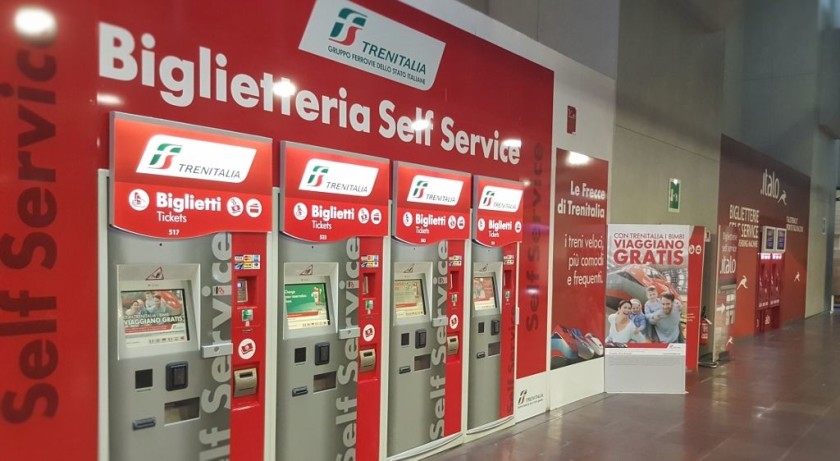
Despite Trenitalia's ticket machines being comparatively easy to use, queues at ticket counters can be lengthy during the day - so give the machines a try.
The machines have excellent English translations, but remember to use the Italian names for towns/cities.
Some machines are card only, but others accept cash and cards - look out for the symbols on the machine, avoid queueing for a machine that only accepts cards if you want to use cash.
When there is a choice of different train services - and therefore different tickets prices, these options are clearly shown on the machines.
The departure times, arrival time and journey time are shown, so you can work out which train will get you to your destination faster - and decide if the time saving is worth the extra cost.
Also be aware that only journeys by Trenitalia trains WITHIN Italy can be purchased from Trenitalia branded machines - in the image above, these are the four machines on the left.
Comparing the prices of taking Trenitalia and Italo trains
Italo trains have separate ticket machines that have Italo branding; they can just be seen on the far right in the image above.
So if you will be buying tickets at the station, just prior to taking a long-distance journey by high-speed train, it's worth taking the time to compare the prices (and timings) of the next trains to depart on the Trenitalia ticket machines, on which its Frecce trains will be available, and the Italo ticket machines.
If you go to the ticket counter, you will only be able to purchase tickets for the Frecce services operated by Trenitalia.
3. Look up Departure Times before you head to the station:
A quirk of Italian train timetables is that on many routes used by the Regionale Veloce and Regionale trains, the trains are much less frequent between around 09:00 and 12:00 - particularly when travelling AWAY from big cities.
If you want to head off from a big city on spontaneous day trip, you'll save (a lot) if you travel by the Regionale Veloce and Regionale trains.
So even if you will be buying tickets last minute at the station, look up the departure times BEFORE you set off for the station.
Avoid a scenario in which you'll be looking up the departure screens to discover that the next Regionale Veloce or Regionale train WON'T be leaving for another two hours or more.
You won't be able to use a ticket for these trains on the next Intercity or Frecce trains.
Firenze/Florence ↔ Pisa:
This route is an exception to the above rule, there will be 2 x trains per hour in both directions during the day; though some trains are faster than others.
The ticket stamping machines:
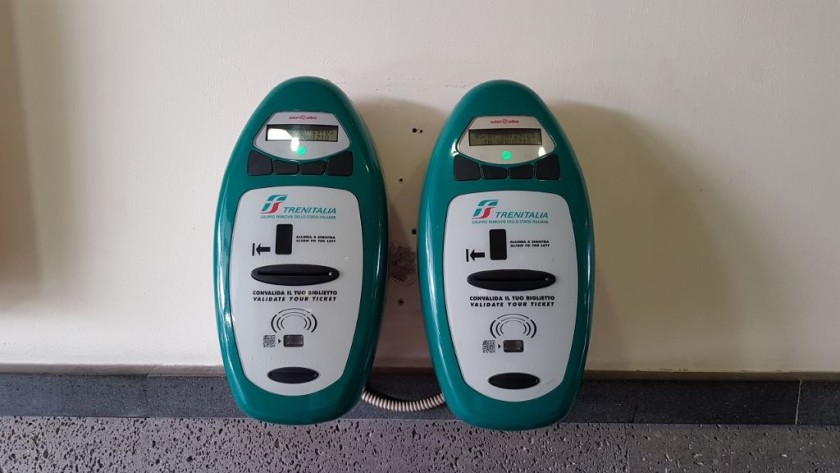
If you have purchased a ticket for a journey by Regionale OR Regionale Veloce trains, you must validate it by stamping it one of these machines, before boarding the train.
It's best to seek out one of these machines as soon as you have purchased your ticket(s) - as it's also too easy to get distracted by buying a coffee etc and then forgetting to do so.
If you don't stamp your ticket(s) you can be fined by the on train conductors, who will inspect the tickets.
You don't need to stamp tickets if you'll be taking any of the Frecce trains or an Intercity train.
Understanding the departure info:
Treno Numbers: (*'Treno = train):
Each individual train service has a unique 4 -dgit train 'treno’ number .
When travelling by AV (Frecce or Italo) or IC Intercity train, this number will be printed on your ticket/reservation.
Look for 'TRENO' immediately followed by a 4-digit number
Looking for this train number on the electronic departure screens can be a big help with finding a train
For example train number ‘AV 1023’ does not mean that the train is departing at 10:23, but that this departure has been assigned this number.
Understanding the electronic departure screens at Italian stations:
The 'treno' numbers, departure times (Orario) and platform/track numbers (Binari) are shown on the electronic displays, which are bi-lingual - English and Italian.
Partenze = Departures; Arrivi = Arrivals; Binari = tracks/platforms (Binario = a specific platform/track, binari is the plural form = tracks/platforms).
Using the four types of electronic departure screen:
At major stations there are four types of electronic departure/Partenze screens that you can use to work out which binario (platform/track) number that your train will be departing from.
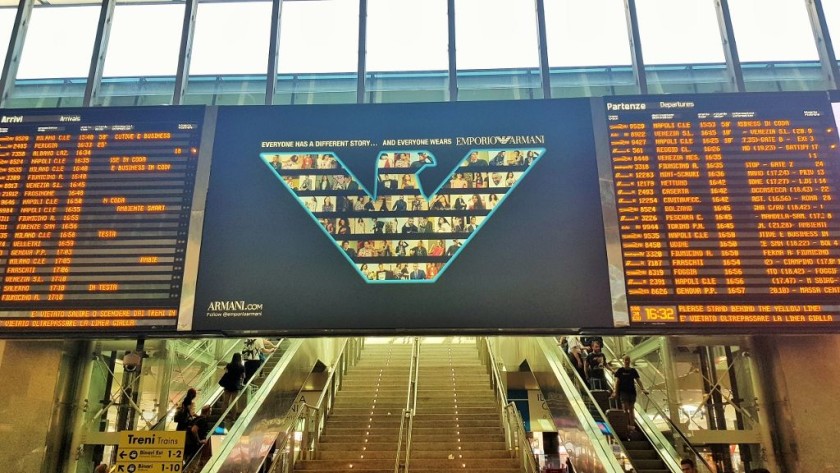
(1) The largest of the screens tend to be housed in ticket halls and to the side or back of departure concourses.
These main screens show the final destination of the train and the intermediate stations the train will be calling at.
The intermediate stations appear as scrolling text under the information header, but other information than the calling points is usually also displayed.
So you need patience and to watch the screens closely (or double check the departure posters – see below).
On these screens the Regionale Veloce trains tend to be listed as RV trains.
Also the more modern of these screens show the specific type of AV (high speed) train being used on each departure.
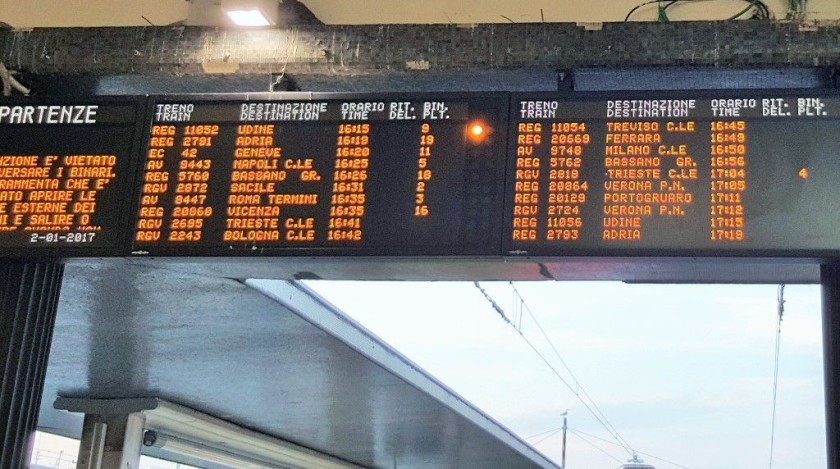
(2) At terminal stations in particular, departure summary screens tend to be located at the front of the concourse, between the concourse and the platforms/binari.
They list only the departure time, train number, final destination and the platform number.
An orange light next to the departure indicates that the train is about to leave.
Something to watch out for is that this type of departure/partenze screen tends to be immediately adjacent to arrival/arrivi screens and it can be easy to confuse the two.
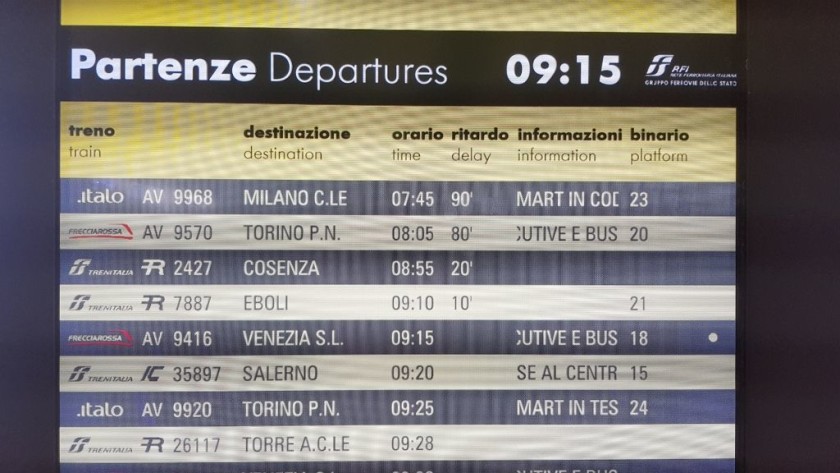
(3) On the platform/binario and in passage ways that link entrances to the platforms/binari are OTHER departure/partenze summary screens.
They list the departure time, train number, final destination and the platform number of the next dozen (ish) trains to depart.
On the more modern types of screen (those that have striped colours) the specific type of AV train is listed.
If you will be making a connection between trains, don't exit the platform/binario until you have checked these screens; the train you are connecting into, may be leaving from the same platform/binario.
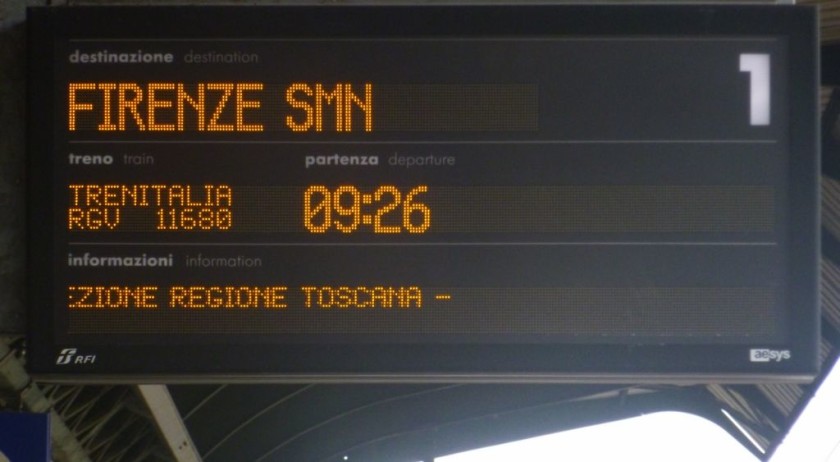
(4) There are also electronic screens on the each platform/binario that give details of the next train to depart.
Note that your train may be a subsequent departure, so if you can’t see it, then it does not mean that you are on the wrong platform/binario.
These screens show the final destination in large type, plus the train number and departure time.
They also show the intermediate stations as scrolling text.
The Coach/carrozza number info screens:
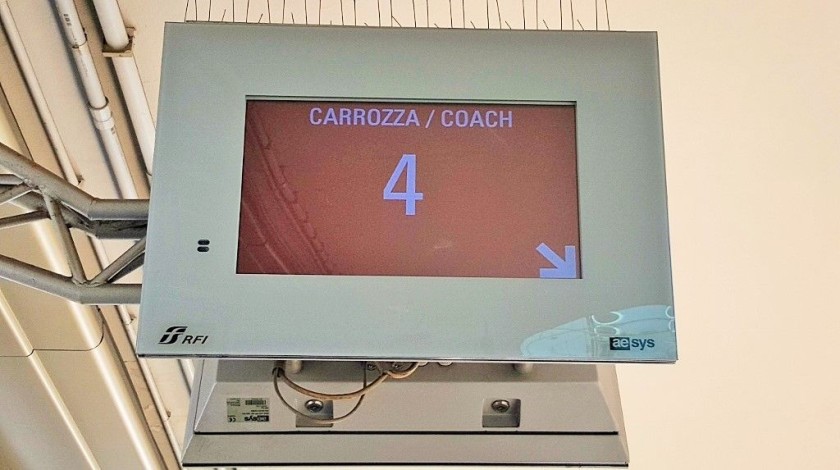
At major stations red electronic screens are being installed along the length of the platforms/binari that are used by AV trains.
Stations that have these screens include Bologna Centrale, Firenze S.M.N., Milano Centrale, Roma Termini, Torino Porta Susa and Verona Porta Nuova.
Around 5-10 mins before the next train is due to depart, these screens will display the numbers of the carrozza/coach/carriage, that will be located beside each screen when the train arrives.
So use them to know where to wait on the binario/platform, for ease of boarding into the carrozza/coach in which your assigned seat is located – match the number on the screen to the carrozza number on your ticket.
It's best to wait in the middle of the binario/platform until these screens update.
Also don't assume that the same coach numbers will ALWAYS be located by the same screen.
The Train Departure Posters:
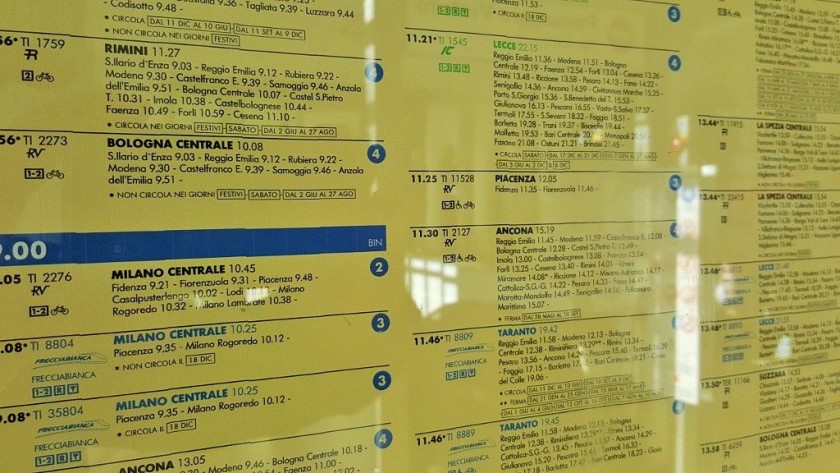
There are also yellow paper departure/partenze posters at MOST* stations
*We're fairly certain that they’re not available at Milano Centrale or Roma Termini, we couldn't find them, so at those stations you have to rely on the electronic departure screens.
They list all the departures in time order, regardless of whether a train only departs on some days of the week, so take care and don't assume that the train you're looking at is departing that day.
'NON CIRCOLA NEI GIORNI' = the train does NOT depart on these days/dates ('festivis' = holiday days).
'CIRCOLA' = the trains ONLY departs on these days/dates.
The big plus of using these posters is that they include ALL the stations that each train is calling at.
If you can't see the station you're travelling to on the departure screens, match the final destination, train number or departure time on the electronic screens with the same info on the posters.
However, the departure time (orario) and platform number (binario) on the electronic info displays can differ to that on the posters.
If it does, then the electronic info supersedes the info on the poster – follow what’s displayed on the screens.
Boarding an express train:
The four steps to finding your way to your train if you have a reservation:
1: Checking the info on your ticket
Check your ticket when you arrive at the station (or if you have just purchased it)
Treno = The train number, The number of the coach you will be travelling is listed to the right of ‘carrozza’ (carrozza = coach/carriage)
Posti = the seat number(s)
The ‘Ora’ to the left of the ‘Partenza’ station is the departure time.
2. Using the main departure screens in the main hall or on the concourse:
Look for the train number and departure time on the electronic departure screens, that match the numbers on your ticket(s).
If your train is not yet listed, you could check the paper departure posters to see which binario/track/platform your train will be departing from.
If you’re not at terminal station, don’t head to the binario, particularly early.
The only facilities on the binario will be a small waiting room.
So if you want to grab a coffee etc, you need to do that in the main station buildings.
Also the electronic departure info can contradict the paper posters – and when it does the electronic screens will have the correct information, so hang back until the electronic screens confirm the departure details.
3. Making your way to the binario (platform/track) that your train is departing from:
Make your way to the binario/track/platform that your train will be departing from, at least 5 mins before your train is due to depart.
If the station has lift access to the binario/tracks/platform and you want to use them, take your time to work out where they are and what the options are.
If you’re NOT boarding a train at a terminal station, your train may not be the next train to depart from that particular binario .
So don’t be surprised if you can’t see it on the ‘next departure’ screens, that you will find on the binario (track/platform).
4. When you have reached the binario (platform/track) that your train is departing from:
Don't move too far along the binario - initially wait where you can see the departure screen.
If the binario (track/platform) has Coach/carrozza number info screens:
When the location of the carrozza/coach that you will be travelling in is flashed up on the screens - move towards the corresponding number.
If the binario (track/platform) DOESN'T have coach/carrozza number info screens:
Just before the train arrives an announcement will be made in Italian followed by English.
However, this announcement WON'T have details of where the coach numbers will be located.
On virtually all Frecce and Intercity trains 1st class will be at one end of the train and 2nd class will be at the other.
The announcement will include details of whether 1st class coaches will be at the front or rear of the train - but they can be incorrect.
If you will be travelling 2nd class the best option can be waiting in the middle of the binario (track/platform) - and then to make a dash towards the coach in which your seat is located when the train arrives
If need be board the train by a convenient door and then walk through the train to find your seat
Also good to know:
Four other things worth knowing about Italian stations:
1. Accessing Lifts / Elevators:
Most large non-terminal stations have lift access to/from the binari/tracks/platforms that the trains depart from.
However, the location of these lifts on the binari/tracks/platforms AND in the main station buildings can be less than obvious.
At Italian non terminal stations, the access to the trains is nearly always by passage ways, that run under the tracks, connecting the binari to the departure halls.
Many stations have more than one of these passage ways and when that is the case, the lifts can be in a secondary passage way.
So the most obvious route to the trains may not have lift access, but alternative routes do.
Stations where this IS the case include – Verona Porta Nuova and Genova Piazza Principe.
2. Catering summary:
The availability of food and drink at stations can vary widely – something that UK visitors will particularly notice is a lack of chain outlets.
Quality restaurants at stations are the exception rather than the norm.
At some busy stations – Perugia, Pisa Centrale, La Spezia Centrale etc, the only food/drink outlet is a snack bar.
At Ancona travellers can also use the Trenitalia staff canteen, but this is not universal.
3. Shopping:
Some stations including Firenze S.M.N, Milano Centrale, Roma Termini, Venezia S. Lucia and Torino Porta Nuova house mini shopping malls - or have mini-malls attached to them.
When that is the case, the shops and the food/drink outlets will be in separate parts of the station.
4. Terminus Stations:
Firenze S.M.N., Lecce, Milano Centrale, Napoli Centrale, Palermo, Roma Termini, Torino Porta Nuova and Venezia S. Lucia are large terminal/terminus stations.
Meaning that they have concourses at one end of the binari (platforms/tracks) so are comparatively easy stations (stazione) in which to change trains.
If you're changing trains at these stations, you won't have to use lifts or stairs to access the binario (track/platform) that your next train will be departing from.
Though if the train you're travelling by CALLS at one of the stations on route to another destination - then it will reverse direction on departure from these stations.
Guides to Italy's busiest stations:
Look for a journey guide
Please support ShowMeTheJourney
This second version of ShowMeTheJourney is exciting and new, so we are genuinely thrilled that you are here and reading this, but we also need your help.
We’re striving not to let anything get in the way of providing the most useful service possible, hence a facility has been set up with DonorBox which can be used to support the running costs and make improvements.
Instead of advertising or paywalls, your financial support will make a positive difference to delivering an enhanced service, as there’s a lot of ideas which we want to make happen.
So if you have found the info provided here to be useful, please go here to say thank you.
The other Italian train travel guides:
The additional station guides:

Simon Harper
I wanted to share my passion for train travel and explain how anyone can take the fantastic journeys I have taken.

This is one of more than 100 train travel guides available on ShowMeTheJourney, which will make it easier to take the train journeys you want or need to make. As always, all images were captured on trips taken by ShowMeTheJourney.
This second version of ShowMeTheJourney is exciting and new, so we are genuinely thrilled that you are here and reading this, but we also need your help.
We’re striving not to let anything get in the way of providing the most useful service possible, hence a facility has been set up with DonorBox which can be used to support the running costs and make improvements.
Instead of advertising or paywalls, your financial support will make a positive difference to delivering an enhanced service, as there’s a lot of ideas which we want to make happen.
So if you have found the info provided here to be useful, please consider saying thank you.






